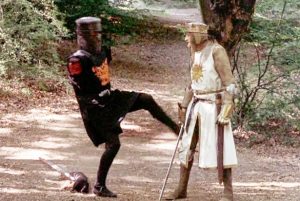Monty Python and the Holy Grail
 If you’ve seen more than one production of the musical “Spamalot,” you know that there are subtle differences each time the show is performed. Why is this? Because the source material, Monty Python and the Holy Grail, was so chock-full of comedy bits and sight gags there is simply no way to include everything from the motion picture in the musical. By the time the new songs are added, and the speed of the dialogue decelerated for a live audience, not all the routines will fit within the confines of a two-act musical. The fact that Monty Python and the Holy Grail was only 90 minutes long shows the genius of the five comedians who comprised the Monty Python comedy team.
If you’ve seen more than one production of the musical “Spamalot,” you know that there are subtle differences each time the show is performed. Why is this? Because the source material, Monty Python and the Holy Grail, was so chock-full of comedy bits and sight gags there is simply no way to include everything from the motion picture in the musical. By the time the new songs are added, and the speed of the dialogue decelerated for a live audience, not all the routines will fit within the confines of a two-act musical. The fact that Monty Python and the Holy Grail was only 90 minutes long shows the genius of the five comedians who comprised the Monty Python comedy team.
For those who might be unfamiliar with their work, “Monty Python’s Flying Circus” was a sketch comedy show which ran on the BBC from 1969 to 1974. PBS brought the series to the United States. The show was unlike anything ever seen before – stream-of-consciousness routines liberally fluctuating between high-brow and lowbrow comedy. The Monty Python troupe could satirize a specific philosopher one minute, then make a joke about passing gas the next. And unlike “Saturday Night Live,” the Python players knew when a sketch was growing tiresome. Their bits were typically longer than those found on “Laugh-In,” but not by much.
In 1975, the six Python members decided to produce their first feature-length motion picture with an overarching plot (in other words, not simply a collection of sketches from their television show). It would be a spoof of the legend of King Arthur, and it would feature the quick-witted humor of their TV program. The result was a classic. Monty Python and the Holy Grail proceeds to poke fun at absolutely everything, but its facetiousness is not topical, causing the film to age well. In other words, there are no specific references to celebrities or political figures of the 1970s. The closest Holy Grail comes to a modern reference is an hilarious sequence in which King Arthur and his knights argue with a common serf about a parliamentary simple majority for purely procedural matters vs. a two-thirds majority for issues of policy.
It is obvious that the Python members (John Cleese, Graham Chapman, Eric Idle, Terry Gilliam, Terry Jones, and Michael Palin) had a blast making this picture. But I believe they had more fun writing the screenplay. For example, in their quest for the Holy Grail a couple of Arthur’s men are trapped by a mythological beast in a situation which presents no obvious way out. Cut to a scene of a sketch artist having a heart attack at his drawing table. He keels over dead, making the terrible beast vanish. You see, if the artist were no longer around to create the beast, the beast therefore ceases to exist. This is the tenor of much of Monty Python’s humor. They broke the classic fourth wall between performer and audience long before Jerry Seinfeld and Garry Shandling. And the resulting spectacle still ranks as one of the funniest films ever made.
Unfortunately, Monty Python never matched the success or brilliance of Holy Grail. The Life of Brian (1979) was amusing, but 1983’s Monty Python’s Meaning of Life was a disaster – an unfunny box office bomb which effectively ended their foray into motion pictures.
Fortunately, Landmark’s Keystone Cinema will be showing Monty Python and the Holy Grail this coming weekend at midnight, both Friday and Saturday (June 24th & 25th). If you’ve never seen it before, you’re in for a treat. If you have seen it before, plan for a sing-a-long. The theatre advises that audience participation will occur (although likely not to the extent of Rocky Horror Picture Show).
Andy Ray also serves as a film historian for http://www.thefilmyap.com/